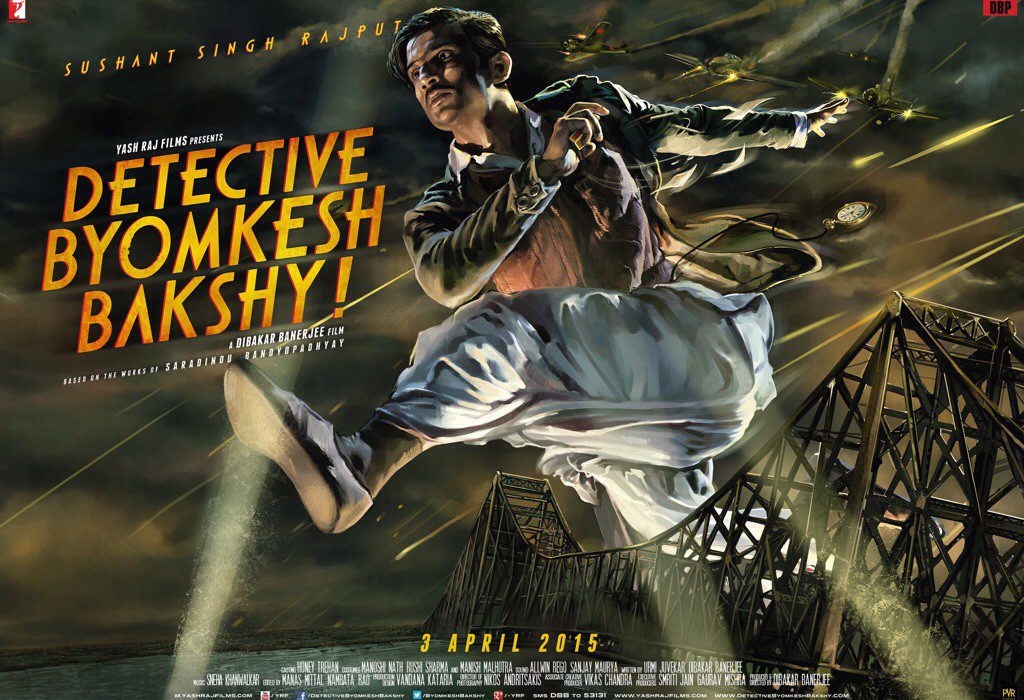Dibakar Banerjee's much-awaited Byomkesh film isn't really a Byomkesh film.
Detective Byomkesh Bakshy!
Director: Dibakar Banerjee
Starring: Sushant Singh Rajput, Ankit Tiwari, Neeraj Kabi, Swastika Mukherjee, Divya Menon
3.5/5
They were referring, of course, to Ray’s Feluda films, an incessant barrage of mediocrity, each offering looking more like a pathetic attempt at wringing out as much mileage as possible from his father’s legacy than the last. In recent times, with Sabyasachi Chakrabarty finally relinquishing the mantle to a younger generation, the decline has been swifter, and Ray’s attempts to distract from the terrible acting by spending on CGI tigers only made the films more cringe-inducing. It was a bit harsh on the poor man, though, the comment; his budgets are about a fortieth of this YRF film. However, Ray’s films have never dared to experiment with his father’s creation, to fiddle around with the stories or—God forbid—the characters in order to appeal to a 21st century audience.
Dibakar Banerjee has no such compunctions towards Sharadindu Bandopadhyay’s Byomkesh Bakshy (not Bakshi; Bandopadhyay never wrote the name in English, so it’s as valid as any other spelling, and the ‘Y’ apparently provides more “typographical balance” than an ‘I’), who’s been seeing a Renaissance of sorts in celluloid—after only two films, Satyajit Ray’s Chiriyakhana and Manju Dey’s Shojarur Kanta, and Basu Chatterji’s classic Doordarshan series in the first 75 years since the first novel was released, this is the seventh Byomkesh film in the last six years. I haven’t met a single reader of the books who’s been entirely satisfied with any of them, not Anjan Dutta’s trilogy, not Rituparna Ghosh’s last film, not Ray’s 1967 disaster. Something tells me that number won’t go up by much after this film—which replaces the excellent origins story in Satyanweshi, Bandopadhyay’s 1932 debut, with an absorbing but ultimately unconvincing whodunit—but Banerjee should do much better with first-time viewers like me.
I went into the cinema with very little Byomkesh baggage, having struggled through the archaic Bangla text of Satyanweshi the previous night and not having seen any of the previous movies or even the television series. It took less than ten minutes for me to be hooked; not only was Banerjee’s recreation of colonial Calcutta a visual treat, the music was irresistibly fresh, the action was slick, Nikos Andritsakis’ cinematography as stunning as always, and Sushant Singh Rajput looked every bit the 22-year-old cocky upstart that he was supposed to be. More importantly, he had excellent chemistry with his eventual sidekick Ajit (Anand Tiwari, the ideal casting choice to play a guy who decides to remain a bachelor for life) from their very first exchange: Byomkesh dismisses Ajit as just another pesky freedom fighter taking up a collection, saying that he doesn’t care whether Gandhi rots in jail; once Ajit tells him he wants his help to find his missing father, Byomkesh rattles off a series of hypotheses over his possible whereabouts—dead, hiding or eloped—and gets slapped for his efforts.
Bandopadhyay’s Byomkesh was always at pains to point out that he wasn’t a detective, but a satyanweshi—seeker of the truth. Rajput’s Byomkesh also rejects the label at first, but has to accept it in order to get the British district collector to take him seriously. It’s a conscious decoupling of personæ, one Banerjee asserting ownership of another Banerjee’s creation (he has, after all, bought the non-Bangla rights to all 32 novels, and plans to start a franchise). The Byomkesh of the books is sure of himself, a figure of the ideal Bengali male: tall, fair, smart, educated in the classics, a little smug, more than a little pretentious (who calls themselves a satyanweshi anyway?).
Rajput’s character, however, is a twenty-something feeling his way around the world, his identity and his exciting new profession. (I’m not even sure he is Bengali; he came to Calcutta from Munger in Bihar as a kid, he says, and speaks excellent Bhojpuri.) He’s got the recklessness of youth—in one memorable scene, he seamlessly transitions between three false identities in order to get close to the man he wants to talk to—but all that disappears when he sees his first dead body. He isn’t infallible; he makes mistakes, dusts himself off, and gets back at it. Neither is he reimagined as some sort of action hero; he doesn’t land a single blow in all the fight scenes he’s part of. Even when doors need to be broken, it’s Ajit who steps up, not him.
Banerjee makes it clear very early on that he isn’t going to be faithful to the book, with a neat little exchange that subverts Satyanweshi‘s climax. In the original story, we find out only at the end who Byomkesh is, since he spends its entirety disguised as a boarder in a locality that has seen a string of murders. Here, he gets caught on Day One because he’s not adequately prepared his back story, a scene that has the twin benefit of establishing Byomkesh’s fallibility as well as introducing us to the character of Anukul Guha, played (to near-perfection) by Neeraj Kabi.
But this failure doesn’t deter Byomkesh babu, who finds himself being sucked into a high-intensity case involving feuding drug gangs, political insurrections, vamps (Angoori Devi, played by Bollywood debutante Swastika Mukherjee, whose job in the film seems to be seen and not heard, for she looks stunning but has the weakest character development of any in the film, barring maybe Satyavati, Byomkesh’s love interest) and World War II. A well-constructed story, and the time and place it is set in, makes it less outlandish than you’d think. It’s risky business, replacing a mystery with an adventure, but Banerjee’s VFX budget, directorial talent and casting choices almost make it work. Sure, it doesn’t have the suspense you’d expect in a Byomkesh film—you know who the villain is fairly early, and the Poirotesque final summation has too few surprises—but it has a flesh-and-blood hero you can get behind, slowly increasing in confidence and resourcefulness, not so much stepping into another man’s shoes as teaching himself to run barefoot.














